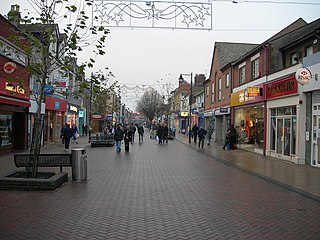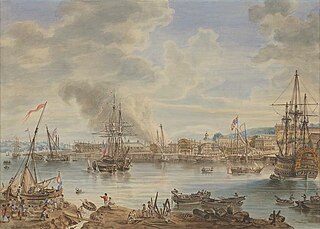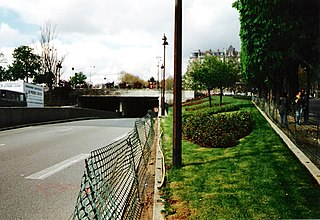
Chatham is a town located within the Medway unitary authority in the ceremonial county of Kent, England. The town forms a conurbation with neighbouring towns Gillingham, Rochester, Strood and Rainham.

Medway is borough and unitary authority area in Kent, South East England. It had a population of 278,016 in 2019. The unitary authority was formed in 1998, when the boroughs of Rochester-upon-Medway and Gillingham were merged to form Medway Towns. The borough is governed by Medway Council, a unitary authority which is independent of Kent County Council, but remains part of the ceremonial county of Kent.

Gillingham is a town in the unitary authority area of Medway in the ceremonial county of Kent, England. The town forms a conurbation with neighbouring towns Chatham, Rochester, Strood and Rainham. It is also the largest town in the borough of Medway.

Chatham Dockyard was a Royal Navy Dockyard located on the River Medway in Kent. Established in Chatham in the mid-16th century, the dockyard subsequently expanded into neighbouring Gillingham.

Sir Joseph Williamson's Mathematical School (SJWMS) is an all boys' grammar school with academy status in Rochester, Kent, and a co-ed sixthform, also referred to as Rochester Math or The Math School. The school was founded by the statesman Sir Joseph Williamson (1633–1701), lord of the nearby Manor of Cobham, Kent, who, in his will, bequeathed £5,000 to set up the school. The school was termed a mathematical school because it specialised in teaching navigation and mathematics to the sons of Freemen of the City of Rochester, the Chatham Naval Dockyard being nearby.

The Loughgall ambush took place on 8 May 1987 in the village of Loughgall, County Armagh, Northern Ireland. An eight-man unit of the Provisional Irish Republican Army (IRA) launched an attack on the Royal Ulster Constabulary (RUC) base in the village. An IRA member drove a digger with a bomb in its bucket through the perimeter fence, while the rest of the unit arrived in a van and fired on the building. The bomb exploded and destroyed almost half of the base. Soldiers from the British Army's Special Air Service (SAS) then returned fire both from within the base and from hidden positions around it in a pre-planned ambush, killing all of the attackers. Two of them were subsequently found to have been unarmed when they were killed.

During the early hours of 31 August 1997, Diana, Princess of Wales, died from injuries sustained earlier that night in a fatal car crash in the Pont de l'Alma tunnel in Paris, France. Diana's partner, Dodi Fayed, and the driver of the Mercedes-Benz W140, Henri Paul, were found dead inside the car. Dodi's bodyguard, Trevor Rees-Jones, was seriously injured and was the only survivor of the crash.

A Royal Naval Hospital (RNH) was a hospital operated by the British Royal Navy for the care and treatment of sick and injured naval personnel. A network of these establishments were situated across the globe to suit British interests. They were part of the Royal Naval Medical Service.

The Kerang train accident occurred on 5 June 2007 at about 13:40 AEST in the Australian state of Victoria, approximately 6 kilometres (3.7 mi) north of the town of Kerang in the state's northwest, and 257 kilometres (160 mi) north-northwest of the city of Melbourne.
The Royal Marines Volunteer Cadet Corps (RMVCC) is part of the Royal Navy's Volunteer Cadet Corps. There are units (Divisions) in Arbroath, Chivenor, Gosport, Lympstone, Portsmouth, and Plymouth.

The Boys in Red accident occurred on January 12, 2008, just outside the city of Bathurst, New Brunswick, Canada. A semi-trailer truck and a van carrying the basketball team from Bathurst High School collided, which killed seven students, the wife of the coach, and injured four other occupants in the van. It was the deadliest transportation accident in New Brunswick since 1989, when a logging truck tipped onto a hayride in Cormier Village, killing 13. It was the deadliest bus accident involving a sports team in Canada until the Humboldt Broncos bus crash in April 2018.
The Gillingham Fair fire disaster occurred on 11 July 1929 in Gillingham, Kent, England, when a firefighting demonstration went wrong, and resulted in the deaths of 15 men and boys.
Paul Knapman DL was Her Majesty's coroner for Westminster, from 1980 to 2011. His responsibility for investigating sudden deaths as an independent judicial officer saw him preside over numerous notable cases.

HMS Princess Irene was a 5,394 GRT ocean liner which was built in 1914 by William Denny and Brothers Ltd, Dumbarton, Scotland for the Canadian Pacific Railway. She was requisitioned by the Royal Navy on completion and converted to an auxiliary minelayer. On 27 May 1915, she exploded and sank off Sheerness, Kent, while being loaded with mines prior to a deployment mission, with the loss of 352 lives.

The Drill Hall Library in North Road, Chatham in Kent, England, was built as a military drill hall in 1902, for the Royal Navy as part of HMS Pembroke shore establishment and barracks. The barracks closed in 1984. The Grade II listed buildings of the barracks, which include the Captain's House, a Mess block, the Pilkington Building, the four barrack blocks, the Gymnasium, and the surrounding walls of barracks were then redeveloped as part of the Universities at Medway, a tri-partite collaboration of the University of Greenwich, the University of Kent and Canterbury Christ Church University on a single campus. The three universities share use of the Drill Hall Library.

On 13 March 2014, an AgustaWestland AW139 helicopter of Haughey Air crashed shortly after taking off at night in fog from Gillingham, Norfolk, United Kingdom, killing all four people on board. Among the victims was Edward Haughey, Baron Ballyedmond.

Stonehouse Barracks, or RM Stonehouse, is a military installation at Stonehouse, Plymouth. It is the home of 3 Commando Brigade and referred to by commandos as 'the spiritual home of the Royal Marines'.

The Deaths at Deepcut Barracks is a series of incidents that took place involving the deaths in obscure circumstances of five British Army trainee soldiers at the Princess Royal Barracks, Deepcut in the county of Surrey, between 1995 and 2002.
The Volunteer Cadet Corps (VCC) is a national youth organisation managed by the United Kingdom's Royal Navy and sponsored by the UK's Ministry of Defence. The VCC comprises:

Major General Matthew John Holmes, was a British senior Royal Marines officer who served for more than three decades in the armed forces. After studying economics at the University of Exeter, he joined the Royal Marines and undertook early tours of duty to Norway, the Far East, Northern Ireland and Zimbabwe. After being deployed to Kosovo and Afghanistan, he commanded 42 Commando Royal Marines from 2006 to 2008 and was awarded a Distinguished Service Order for his leadership in Afghanistan, as well as the United States Legion of Merit for his exceptionally meritorious service. Holmes served as Commandant General Royal Marines from 2019 to 2021.

















